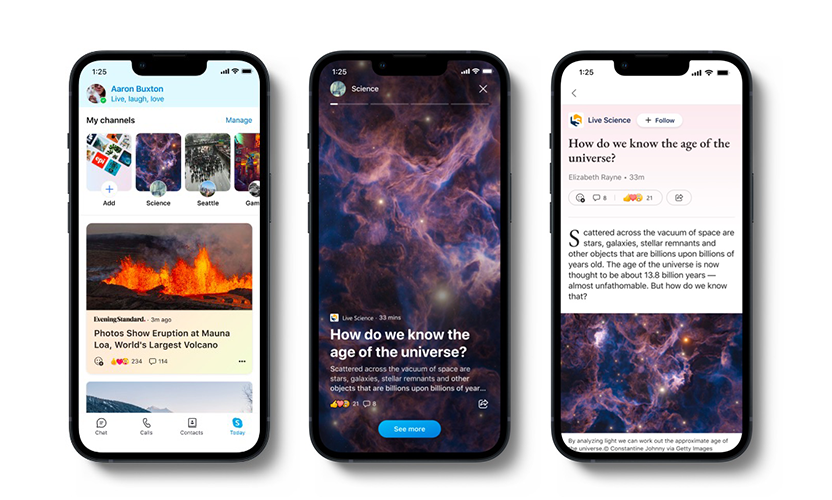Was Skype Ahead Of Its Time? Analyzing Its Accurate Technological Predictions

Table of Contents
Pioneering Peer-to-Peer Technology
The Significance of P2P Architecture
Skype's reliance on a peer-to-peer (P2P) network was revolutionary. Unlike traditional client-server models, Skype distributed the workload across its users' computers. This decentralized approach reduced reliance on centralized servers, a significant technological leap anticipating the decentralized internet we see today. This aspect of Skype's technological foresight is particularly noteworthy.
- Reduced infrastructure costs for the company: By leveraging users' bandwidth, Skype minimized its own server infrastructure needs, resulting in substantial cost savings.
- Improved call quality and resilience: The distributed nature of the P2P network made Skype more robust and less susceptible to outages compared to centralized systems. Call quality was often better, especially during peak usage times.
- Early adoption of a model now seen in blockchain and distributed ledger technologies: Skype's P2P architecture foreshadowed the decentralized models used in modern blockchain technologies, highlighting its advanced technological foresight.
Impact on VoIP Technology
Skype's success popularized Voice over Internet Protocol (VoIP), making it accessible to the masses. This dramatically changed how people communicated, foreshadowing the dominance of VoIP in modern communication. Its impact on the development and acceptance of VoIP technology is undeniable.
- Lower call costs compared to traditional landlines: Skype offered significantly cheaper calls, particularly for international communication, making it a disruptive force in the telecom industry.
- Increased accessibility to global communication: Skype broke down geographical barriers, connecting people across the globe affordably and conveniently.
- Opened the market for other VoIP services and applications: Skype's success spurred innovation and competition, leading to a flourishing market of VoIP services and applications.
Early Adoption of Video Conferencing
The Rise of Visual Communication
While video calling existed before Skype, its seamless integration and widespread adoption made video conferencing mainstream. This presaged the current era of ubiquitous video conferencing tools used in business, education, and personal communication. Skype's technological foresight in this area is evident.
- Facilitated remote work and collaboration before its widespread acceptance: Skype enabled remote work and collaboration long before it became a widespread practice, showcasing remarkable foresight.
- Improved personal connections across geographical distances: The ability to see and interact visually strengthened personal relationships, particularly for those living far apart.
- Set the stage for advancements in video compression and streaming technologies: The demand created by Skype’s success spurred advancements in video compression and streaming technology.
Predicting the Demand for Visual Interaction
Skype’s early embrace of video showed a profound understanding of the human need for visual connection in communication. This prediction is validated by the booming success of video-based social media platforms and applications today. Skype's technological foresight in understanding human communication needs is remarkable.
- Integration of video calls directly into the platform, making it intuitive to use: Skype made video calling effortlessly accessible, contributing significantly to its widespread adoption.
- Increased user engagement through a richer communication experience: Video added a layer of richness and engagement that enhanced the communication experience compared to purely audio-based interactions.
- Anticipated the rise of video-centric social media and communication platforms: Skype’s early adoption of video laid the groundwork for the current prevalence of video-based platforms like Zoom, FaceTime, and Instagram Live.
Integration of Instant Messaging and File Sharing
The All-in-One Communication Platform
Skype's combination of instant messaging, voice calling, and file sharing into a single platform provided a comprehensive communication solution. This foreshadowed the convergence of various communication tools into integrated platforms seen today. This exemplifies Skype's remarkable technological foresight.
- Enhanced efficiency and convenience for users: Having multiple communication tools in one place streamlined interactions and improved efficiency.
- Simplified communication across multiple channels: Users could seamlessly switch between messaging, voice calls, and file sharing within the same application.
- Predicted the trend towards unified communication platforms: Skype’s integrated approach paved the way for modern unified communication platforms that offer a single hub for various communication needs.
Anticipating the Need for Seamless Data Transfer
Skype’s file sharing capabilities anticipated the rise of cloud storage and the demand for quick and easy file transfer, now a crucial component of modern communication applications and collaboration tools. This highlights Skype's forward-thinking approach and accurate technological predictions.
- Early implementation of file transfer features, contributing to the ease of data exchange: Skype made sharing files easier than ever before, accelerating collaboration and information dissemination.
- Facilitated collaboration and information sharing among users: The ability to easily share files significantly improved collaboration and efficiency for individuals and teams.
- Precursor to modern cloud storage and file sharing services: Skype's file sharing laid the groundwork for today's robust cloud storage and file-sharing services.
Conclusion
In conclusion, analyzing Skype's technological trajectory reveals a remarkable degree of foresight. Its adoption of peer-to-peer technology, early embrace of video conferencing, and integration of various communication tools all accurately predicted significant trends in modern technology. While the landscape of communication has evolved, Skype's legacy as a pioneer in online communication remains undeniable. Was Skype ahead of its time? The evidence strongly suggests it was. By understanding Skype's technological innovations and its remarkable technological foresight, we can better appreciate the evolution of online communication and the enduring impact of Skype's influence on our connected world. Further exploration into Skype's technological foresight can provide valuable insights into future communication advancements.

Featured Posts
-
 Isabela Merceds Fantastic Four Role A Hype Worthy Addition To The Marvel Universe
May 07, 2025
Isabela Merceds Fantastic Four Role A Hype Worthy Addition To The Marvel Universe
May 07, 2025 -
 Mariners Spectacular Catch Outfielders Dedication Vs Giants
May 07, 2025
Mariners Spectacular Catch Outfielders Dedication Vs Giants
May 07, 2025 -
 Cavaliers Victory Over Bulls Propels Them To First Place In The East
May 07, 2025
Cavaliers Victory Over Bulls Propels Them To First Place In The East
May 07, 2025 -
 Shooting At Arizona Restaurant Results In Multiple Injuries
May 07, 2025
Shooting At Arizona Restaurant Results In Multiple Injuries
May 07, 2025 -
 Warriors Coach Kerr Optimistic About Stephen Currys Return
May 07, 2025
Warriors Coach Kerr Optimistic About Stephen Currys Return
May 07, 2025
